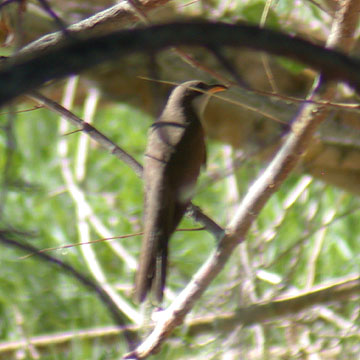[Originally appeared in the Sierra Wave newsletter, Vol. 24, No. 5, May-Jun 2006 – click here for original with photos]

Yellow-billed Cuckoo
Myth: The cuckoo barely reaches Inyo County and doesn’t really belong here.
While the Owens Valley is now on the eastern edge of its range it was not always so. The Western Yellow-billed Cuckoo was originally found in British Columbia, Washington, Oregon, and Nevada as well as throughout California (San Diego to Sonoma Counties, San Joaquin and Sacramento Valleys, Kern to Shasta Counties, plus Siskiyou, Inyo, San Bernardino, and Imperial Counties). They have been extirpated from British Columbia (in the 1920s), Washington (by 1934), and Oregon (by 1945) and there are no proven breeding records in Nevada since the 1970s. The more than 15,000 pairs of breeding Yellow-billed Cuckoos in California have been reduced to 30 pairs in less than a century. This is recognized by science as a catastrophic range reduction and will result in the total extirpation of the Western Yellow-billed Cuckoo unless significant steps are taken to intervene. The primary causes of this precipitous decline are destruction or degradation of their preferred riparian habitat, pesticide use directly in orchards and indirectly through their prey, and grazing which removes or reduces the understory and prevents willow and cottonwood growth.
Myth: There is very little or no cuckoo habitat in the Owens Valley.
Cuckoos breed in open woodlands with a low understory of dense and scrubby vegetation. They have also been found in abandoned farmlands, overgrown fruit orchards, and dense thickets along streams and marshes. Nests are often placed in willows but nearby cottonwoods are used extensively for foraging. Their main foods are primarily large insects such as caterpillars, katydids, grasshoppers and crickets. All of these requirements are available in the Owens Valley albeit in less than bountiful quantities. The restoration of 62 miles of the Owens River will significantly enhance habitat that appeals to cuckoos as well as quail, fish and many other species. Much can be gained by looking at the Kern River Preserve just south of us with a similar biogeography. A major effort was made to revegetate the riparian habitat along the Kern River, which had been degraded by man. The results were phenomenal with two endangered species, Yellow-billed Cuckoo and Southwestern Willow Flycatcher, making a remarkable comeback. The residents, ranchers, and conservationists worked together on a program that would benefit all parties. But the biggest beneficiaries were the flora and fauna that existed a century or more ago – being allowed, in fact, encouraged to flourish once again.
Myth: The cuckoo isn’t being found in Inyo now.
The paucity of professional researchers and serious birders is reflected in the few records of the Yellow-billed Cuckoo. The extent of cuckoo distribution or the numbers of this species in the Owens Valley for the last 150 years is not known by scientists or Owens Valley residents. There have been a few ornithological surveys throughout the last century and a half; none focused on the cuckoo. During the 1980s and early 1990s Dr. Steve Laymon, cuckoo expert, conducted studies in the Owens Valley that were cuckoo specific surveys. These most recent surveys were short-term and were but a peek into the biological picture but the results indicate that there is good habitat in the Owens Valley for the cuckoo. Without a concentrated cuckoo project where the protocol is specifically designed for that species and is a long-term study, no one can know how many there are in the county in an average year or decade and whether they are breeding or not. This bird is retiring and secretive and not easy to find. Therefore, the lack of proven records may reflect a lack of birds or a lack of looking for birds in general and not the result of cuckoo specific surveying. One found in Bishop 5-6 June 2002 was photographed by Chris Howard.
Myth: The people of Inyo County should not have to pay all this money for just one bird on the edge of its range.
The people of Inyo County will not pay for cuckoo habitat enhancement. The LADWP is charged by the court to enhance cuckoo habitat, as well as other enhancements, as restitution for the environmental damage they have caused to the Owens Valley due to their water export policies. The money comes out of their pockets, not from Inyo County residents.
Myth: Motorized vehicle access will be denied to all and a chain link fence will be built all around Baker Meadow with human access denied.
Motorized vehicle access is already denied at Baker Meadow to all without a key to the gate. There are no plans, or intent, for a chain link fence to enclose Baker Meadow and prevent access by people. You need not believe anything in this article or any comments made by LADWP, Sierra Club, Owens Valley Committee, Inyo County, or your neighbors. You are encouraged to research the Yellow-billed Cuckoo yourself and decide which rumors are factual and which are not. If mankind is to be judged by what he leaves behind, let it reflect his intelligence, not his ignorance.
Tags: flycatcher
